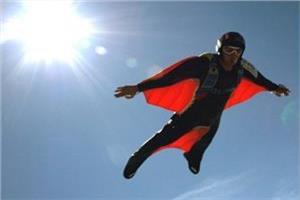
If you’re unfamiliar with wingsuits, they’re essentially special jumpsuits with inflatable arm and leg “wings” that allow the wearer to glide through the air after jumping from a plane, cliff, or other high structure. They’re also sometimes called “squirrel suits,” which I find both amusing and appropriate as the dynamics and appearance are very similar to those of a flying squirrel – who, presumably, have never thought of using their built-in wingflaps to jump from a plane, instead preferring to glide more cautiously from tree to tree.
Humans are known for being significantly braver than squirrels, though, so wingsuit flying and BASE jumping have formed a whole subculture of flying nuts. (I mean that they’re nuts about flying, rather than nuts that fly…whatever.) Like fans of any extreme sport, these birdmen (wingsuits are also called birdman suits!) are constantly working to improve their craft, while on the ground as well as in the air. Flying takes skill to master, but that doesn’t mean that a birdman can’t help himself out a little bit by adding some enhancements to his (or her) suit.
Squirrel is a wingsuit design company that regularly tests out new features and designs to try to increase flight performance for base jumpers and wingsuit pilots. A source who has been testing one of the suits told us a bit about some 3D printed enhancements the company made.
“One of the biggest efficiency losses in aircraft flight comes from the generation of wingtip vortices, wherein turbulent air spins around the tip of the wing, disrupting laminar flow and creating drag,” he said. “Airplanes typically minimize wingtip vortices through the use of winglets, which are small wing extensions at the tip which curve upwards. As air flows down the wing around the tip, the winglets eliminate most of the wingtip vortices, resulting in more efficient flight.”
Squirrel 3D printed some nylon wingtips on a hobbyist 3D printer, then pinned and bonded the multiple pieces together. Then – test flight! Ultimately, no performance gain was to be found, but “no flying squirrels were harmed in testing.”
While I have no plans to ever attempt flying without an airplane myself, it’s quite a lot of fun to watch those who do. Would you be interested in trying something like this? Discuss in the 3D Printed Winglets forum over at 3DPB.com.
[Note: article updated to remove protected image of the wingsuit.]